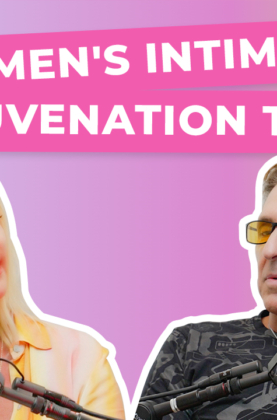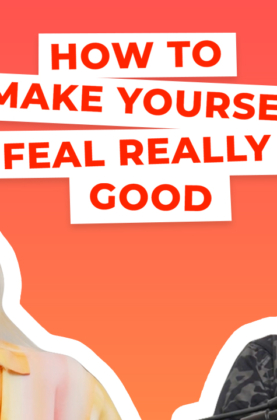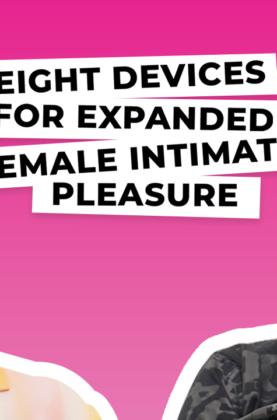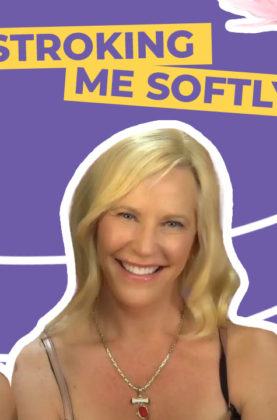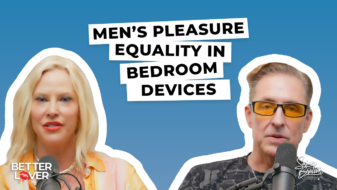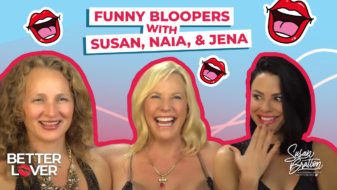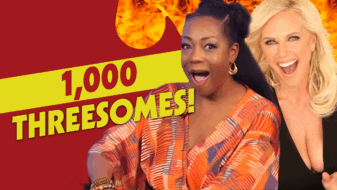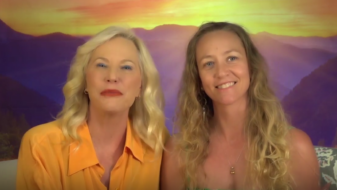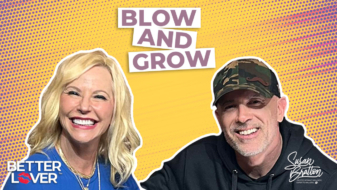Exploring the Mind-Body Connection in Sexual Pleasure: Insights from Dr. Nan Wise
betterlover
In this insightful conversation between Susan Bratton and Dr. Nan Wise, a renowned expert in neuroscience and psychotherapy, the importance of the mind-body connection in sexual pleasure is explored. Dr. Wise’s extensive certifications and accreditations in the field make her a trusted authority on the subject. The discussion delves into understanding how pleasure is sensed, felt, and created in the body, emphasizing the role of the brain as the biggest sex organ. They also discuss strategies to enhance pleasure potential, overcome obstacles, and practices to expand one’s pleasure potential. This conversation is a valuable resource for individuals seeking to deepen their understanding of the mind-body connection and its impact on sexual experiences.
Full transcript
Susan Bratton: Hello, I’m Susan Bratton, intimacy expert to millions and host of the Better Lover video channel. And I am here with Dr. Nan Wise, who has written a wonderful book called Why Good Sex Matters, right up my alley. And I want to tell you some of Dr. Wise certifications and accreditations because I want you to understand the gravitas of this conversation with this very important thought leader in the area of the intersection of neuroscience and psychotherapy, psychology.
So, Dr. Wise is a licensed psychotherapist. An ASECT certified sex therapist, which is the highest order of certified sex therapist. She’s a certified relationship specialist through the American Psychotherapy Association, a behavioral neuroscience researcher. Part of the Psychology Division of the Rutgers Newark College.
She’s a Fellow of the American Psychotherapy Association. She’s a Fellow of the National Board for Clinical Hypnotherapists. She’s a Board Certified Diplomat of the American Board of Examiners in Social Work. As I said, the author of Why Good Sex Matters Understanding the Neuroscience of Pleasure for a Smarter, Happier, and More Purpose Filled Life, beautiful title.
Her website is AskDoctorNan.com and you can follow her at AskDoctorNan on a lot of social media. And I really wanted to run through that litany, though it’s a long introduction with a lot of certification because I want you to understand All of the aspects of this amazing woman and what we’re about to talk about today, which is not only how pleasure is sensed, felt and created in the body, but why it’s so darn important and what are some of the things that you could be doing to have and achieve more of your pleasure potential?
What gets in the way? How we can remove the obstacles and the practices that are required to move forward to expanding your own pleasure potential. Because that’s what I’m all about here. And Dr. Nan and I have been really looking forward to this. So welcome, Nan. How are you today?
Dr. Nan Wise: Thank you, Susan. And boy, oh boy, you are so good at this.
I am so impressed just about how you present yourself and how you presented me today. Thank you so much for that.
Susan Bratton: Well, you have done so much work, taken so much education, done so much research that I want people to understand what a really special human being you are. And I really appreciate your, your work, specifically in understanding two.
So, I’m going to talk about two major things. One, the mind body connection. I mean, you can say to anybody, what’s the biggest sex organ in your body? And everybody will say, the brain. But that’s about the limit of our understanding in the general population. And my fans and followers are people I call sexual seekers.
They know there’s more, and they’re pursuing it. And so, I think it’s particularly helpful for us to have the conversation about Okay, it’s the biggest sex organ, but why and how and how do we leverage it even more? Because what I like to do is I like to help people optimize their pleasure. I’m always teaching them about things like orgasmic activation and awakening more neural pathways.
But I want you to take us A little deeper into exactly how this brain body connection works so that we can begin to harness the power of our own mind body connection. And then the other piece that I really want to talk about is what what you’ve written about in your book, Why Good Sex Matters, about the seven core emotions, because I think for a lot of us, we’re trying to move from the trauma, the lack of knowledge that creates fear.
Fear. The repression, the abuse, the you know, all of the things that are kind of the problems that create our desire, but are asymptotic. We never quite get their reach for that pleasure. And we have to understand what those fundamental issues are to pinpoint our area to begin to dissect that and remediate it so we can get to our pleasure.
So I want to really start with the mind body connection that I want to talk about the core emotions and then I want to specifically talk about maximizing our orgasmic potential. So that’s that. Does that sound like a pretty good flow?
Dr. Nan Wise: It sounds like a great plan. So good. Let me start with. Just talking about what pleasure actually is and it all starts with the Understanding that pleasure is not only not a luxury Pleasure is a function built into the brain mind body to Move us towards things that feel good and are good for us and move us away from things that are painful, hurtful, stuff that’s really not good for us.
Susan Bratton: So it’s a protection mechanism. Pleasure can be a protection mechanism. It’s to keep us alive.
Dr. Nan Wise: It’s survival. Exactly. It’s a survival mechanism and I would go beyond that and say it’s a survival mechanism. So what pleasure is people used to think of the reward system. All of this circuitry is the reward system.
So that feeling good as a reward, but what we now understand largely in part, Due to the research of many researchers, including my mentor, Yaak Panksepp, who’s the guy who mapped out all of the circuitry for all of the core motions. The, what we used to think of the reward system is really a learning reinforcement system.
So when we understand that focusing on pleasure is really reinforcing how the brain mind body is supposed to work so that it can work more effectively. So let’s back it up and let’s talk about brain mind body. There are no arbitrary distinctions between any of them. Everything behaviorally is biological.
Every thought, every wish, every fantasy, everything that we experience as human beings is based on the substrate of our biological systems. So actually there are so many neurotransmitters all over the body, not just in the brain, that when we think about The brain and the body is being separate things or the brain and the mind being separate things or the brain body and mind being separate things.
It’s really misleading. Okay, that’s good. So, I collaborate with Stanford University’s lab, which is Behavior is biology, and I do some really very interesting work with that lab because we need to better understand how the brain mind creates our behaviors as well as our behaviors. Thoughts, feelings, desires, fantasies, so that we can help people who are challenged, whether it’s with mood disorders, sexual issues, even things all the way up to psychosis, and stress related illnesses are really a function of the balance in the brain mind body being way out of whack.
So how about I start now talking about how the three level brain mind works. Yeah, that was great. One of the, the, the biggest reason I wrote this book is to look at our relationship with pleasure, specifically sexuality, but in general pleasure, as a window into how the emotional brain is working. So when people have challenges with pleasure, it’s an indication that something is not working in what I call the basement of the brain.
The basement of the brain are the evolutionarily oldest parts of the brain that we share with all mammals and many other animals. So there’s a big debate in psychology. Do animals have emotions?
Susan Bratton: How, how could there even be a debate about that?
Dr. Nan Wise: Well, this has been a huge, you can see that they do a huge problem in psychology to this day is kind of anthrop, anthrop, anthrop, anthropomorphism, anthrop izing.
That’s it. Mm-Hmm. . Yeah. That we are so different than animals. Now, EP says, and he’s the guy who mapped out these seven core systems. Mm-Hmm. that live in the basement of the brain, that at the. Basement of the brain or the bottom of the brain, brain mind were very similar to these, you know, four legged creatures and at the top of the brain that were very different.
So let’s talk about those core emotions and what makes them core Susan is they live in our bodies. We feel them. We always know. When we’re feeling these strong affects because they’re so primary, you know, when you’re feeling enraged, you know it. When you feel fearful, you know it. When you’re feeling lusty, you know it as well as all of these things, we feel them in our bodies.
And these seven, they’re actually emotional instincts that are wired in. Like you said, first survival, to go into the world, to get food, water, social connection, everything and anything that we need for survival, as well as to protect ourselves. So let’s talk about the first system, the granddaddy of all the systems, which is the seeking system.
And isn’t it interesting that you talk about pleasure, people pleasure seeking, looking for. Exploring that system, which we used to think of as the reward system is really the source of our motivation, our desire, our desire, our enthusiasm for going into the world to get our needs met. Now, if you see people that are depressed.
Yeah, what’s happening is the seeking system gets flattened and it gets flattened by a lot of the ways that we’re using our attention, which I talk a lot about in the book. And we can circle back to that about we talk about how do we improve the functioning of those systems for now. Let’s just talk about the seeking system, the motivation, the getting us into the world.
Exploring actually feels good. Yeah. People and animals like to forage and to explore. So that system works with all of our other systems. And when we think about these systems, I broadly put them into two categories. One are the defenses. So the defenses are things that we need to defend ourselves. Fear, obviously, that’s kind of very intuitive that we need fear to be able to protect ourselves from things that are dangerous, right?
The other very important defensive system is rage. Rage tells us, gives us information that we’re being either attacked or resources are being threatened. Every emotion, like I like to say as a clinician, has information that’s important for us to pay attention to. It may have inflammation, which is a history.
That may not have anything to do with present time, but when people get re stimulated into bad experiences or trauma, Yeah, triggers. The old, yes, triggers are when these emotions continue to live on in our bodies beyond the past. So, The last but I think most interesting of our defensive systems is panic, grief, sadness.
So panic, grief, sadness is wired into us so that we stay very close to our important supports. And what that means is even something like a baby chick, which is not even a mammal, has a panic grief system, if that little chick is separated from its mother, that baby chick is going to experience great distress because the separated animal, baby animal, is a dead baby animal.
Yeah. So this is prim mortal stuff that we feel in our bones, we feel in ourselves. And the panic grief system, interestingly enough, is the system that seems to be impli in implicated mm-Hmm, , sorry, implicated. When we have psychiatric disorders, such as depression, panic disorders, other kinds of emotional disorders that flatten our ability to feel pleasure, because it’s pain in our bodies.
And guess what the antidote for that panic grief system is? Paul? Well, it’s actually wired into us in the way of the care system. So we talked about the defenses, fear, rage, panic, grief, and now we’ll talk about what I call the affiliative systems, which are the systems that are about connection. Okay. The care system is, Wired into us so that we’ll care for our young and care for each other and their system is powered by our own manufactured internally manufactured opioids, as well as things like oxytocin, these neuropeptides that give us a feeling of well being.
So when you have a normal day. brain that has a well developed care system, getting connection with people is going to make you feel good. It’s the source of our feelings of calm and well being. If unfortunately you’ve gotten a bad draw from the gene pool and you have certain sort of predispositions to those neurotransmitters and receptors not working so well, you may end up.
Seeking substances outside of you like endogenous opioids, you know, painkillers to make you feel better, substances to make you feel better. What about introverts? Well, that’s a great question. Well, it’s a great question. What we do know about introverts is they tend to get a little bit more stressed out by social contact than extroverts.
And there is probably some predispositional things going on where people may end up being more on the introvert part of the continuum rather than the extrovert. But when you get back to feeling good with and through our social connections with and through our relationships, That’s what feeds what I call healthy hedonism, which is things that feel good and are good for you.
So the care system is like the most important, I think, of all of our affiliative systems because it’s the basis of our ability to have connections with, I think, ourselves and other people, which are so important for our ability to be healthy.
Susan Bratton: Can I ask you a question about that care system? Absolutely.
It seems like a lot of people who have anxiety and depression, have issues of abandonment and lack of good care in their childhood is Is it, are you able to recover from the scene? There’s a lot of conversation about poorly, poorly attached childhood, poorly attached parenting, poorly attached relationships, you know, all of these kinds of things feed into setting early systems where we don’t feel like we can get the care that we need in you in all of the time that you’ve been practicing with individual clients over the years as well.
Because you haven’t spent all your time in the lab in the MRI with the MRI machines, you’ve been seeing clients and helping them with their anhedonia and their, their difficulties attaching and their difficulties, calming and their difficulties, feeling sensation and those kinds of things. What’s the prognosis for people who are struggling with any of these kinds of issues with their care system being disrupted living in more panic, anxiety and fear, having difficulties settling into acceptance of nurturing and care. Are there straightforward paths to fixing these things for most people? Or like, how do you determine whether somebody’s got a chance or they’re kind of screwed for life? Are people screwed for life that have had these, these things impact them?
Dr. Nan Wise: There is no Deb, no debate over the quality of our early childhood care experiences shape the tonality of both the care system and the panic grief system. So you hit the nail on the head and you also made an excellent commercial for my next book. You’re welcome. Which addresses this. I’ve already worked this out with my co writer, my agent.
never too late to have a h
You know, all of this is a combination of early childhood experiences and some predispositions to these systems not working so well to begin with. So early childhood experiences can dial down reactive defensive systems and make people more calm. Early childhood experiences can activate the defensive systems.
And just like you said, Greatly impair our capacity for attachment, even with ourselves. Our relationship with ourselves is pivotal to our relationships with others. So I do believe that under many circumstances, Susan, we can repair. These ruptured attachment styles based on, for example, fractured parenting where parents can’t, because of intergenerational trauma, they can’t do a good job parenting.
So, you know, I think the forecast is pretty darn good. Great. That people can learn. One of the things that lingers on when people have had trauma in childhood is Because they did not have the ability to defend themselves, they didn’t have the resources, they had to create emotional habits that were also based on decisions that they made about themselves and the world.
On that limited kind of nurturance and lack of safety, So, as adults, we can take a lot of good lessons about how we can get this old learning. Trauma is simply old learning that lives on in the body. And there are wonderful tools, I have some of them, in Why Good Sex Matters. And in a way, in a way, my new book Why It’s Never Too Late to Have a Happy Childhood is kind of a prequel to the Why Good Sex Matters book because it helps people do the kind of repair on their own attachment styles, on their views of themselves and the world, to make decisions That would be like someone who did have a happy, secure childhood.
So we can’t go back and change our experiences in that they happened. But we can change the stories that we have about ourselves and the world. And what I love to think about is we can become the hero of the childhood story. And really repair our relationship first and foremost with ourselves and make different emotional habits by taking these bottom up tools to get the trauma out of the body and learn how to reset the autonomic nervous system.
The autonomic nervous system, for those people who might not remember this, is what controls everything. Eating, sleeping, breathing, everything that goes on, all our hormones, all of our behaviors are really regulated by that. And the flight or fight system, which is one division of the autonomic nervous system, has us on constant alarm.
So if you look at most people most of the time, the way that we’re living, Susan, is contributing to people having very active. flight or fight system so much that we end up with higher blood pressure because our bodies are always acting as if we have to run from saber toothed tigers. When in fact, we’re sitting at our desks and the stress is going on in our heads.
Susan Bratton: Can I, can I ask you a couple of other quick questions? Sure. One of the things that I’ve noticed in working with people over the last couple of decades around their relationships is that I talk to people a lot about what’s blocking you from having the pleasure that you desire. And for it, with the exception of I don’t have a partner, okay, so you can have a relationship with yourself, but I’m really talking about it in a partnered experience.
What’s holding you back? And for a lot of people, okay, I’d say 80 percent of the people who are struggling, it’s a health issue of some sort. One or the other of the partner has a health issue. And we all know that your libido and your desire for sex and pleasure are, you know, really the same, the other side of the same coin is your health.
When you don’t feel well, you don’t have libido. You just, you just have to fix the system. But there’s 20 percent of people who. Have an issue with betrayal. Someone has betrayed them in their love and sex relationships and their intimate connection and they can’t seem to move on. 80 percent of people seem to be able to move on and Forgive, forget, give somebody new another chance, give the same person another chance, et cetera, or chance after chance after chance, even like everybody’s on their journey and you’re a witness to another person’s journey.
They may betray you repeatedly, but you hold your love for them. Those are, that’s the other end of the spectrum. And I was talking to Kashif Khan, who runs the DNA company, and he studies genetic SNPs. And he said that he thinks there are some very specific genetic snips around serotonin and dopamine pathways that for a particular small segment of the, of the world, this 20 percent or so, that’s kind of both of us, that was our, he came to it from genetic snips and I came to it from just longitudinal data.
I do a lot of longitudinal surveys and, he said, I think it’s that there are certain people who have a serotonin and dopamine profile that when they their brain remembers has the memory of the betrayal, it’s like a fresh wound. They bleed again every single time. The memory doesn’t fade. They’ve got this almost photographic body print of the betrayal that Keeps them so upset about it that they literally never get over it.
And I have noticed that there are older people and you and I are both, we deal with older people too. We deal with people in their 60s, 70s, 80s, 90s. I don’t even think 60s old anymore, Nan. And I feel like I’m in midlife, but, we deal with people who have deep seated bitterness where they’re still coming up with things that happened 50, 60, 70 years ago that they’re still pissed off about and they can’t let go.
And I wonder, in your research on these core emotions and on self protection and self preservation, what you have to say about that.
Dr. Nan Wise: Well, we do know that there are some people based on certain copies of genes, alleles that control things like serotonin, dopamine, some of the other neurotransmitters, certainly oxytocin and everything that make people more at risk of being deeply imprinted by trauma.
Susan Bratton: Okay. So you’re, you’re seeing a parallel.
Dr. Nan Wise: And so we know this, we know this from behavioral neuroscience, which I teach. What I would like to say is another way to look at this is that fear conditioning. Looms large for people, especially people who have, if we look at these core emotional systems, very hair triggered defenses, defensive systems, so these people are going to have a hard time letting go of the defenses, the fear, the fear, the fear, the fear, the fear, the fear.
The rage, the panic grief. So if they’re not able to have a better balanced sort of core emotional system what they’re gonna ha what’s gonna happen to them is they’re gonna live in their pain.
Susan Bratton: That right, they live in their pain. So how do they fi how do those people who are living What if you’re married to someone who’s living in their pain?
And they just can’t move through it, or they’re living in their betrayal and they can’t live through it. How does a person help themselves get through it? Is it possible to get through it?
Dr. Nan Wise: There’s no question that it’s possible to get through it. What I think is most important, and this is really what’s informing a lot of the work that I’m doing now, is educating people how that brain mind works.
Conditioned learning, which is where trauma lives, is the mid level mind, and we’re not all that conscious of it. We know what’s at the top of our mind, what we’re thinking about, kind of our window on the world. We often know what’s going on in the core emotions because we feel them. Mad as hell, we’re sad, we’re, you know, we’re feeling fear, whatever’s going on.
What we’re not aware of often is these automatic conditioning things that happen where we’re associating pain with, for example, connection or intimacy. And when people understand how the brain mind works, they can work it better. So what I find is when I work with people who have a lot of emotional pain and probably very inflamed panic grief system because that’s really the substrate of emotional pain, when they can understand that and when they have the concept, okay, so that is because I’ve had these experiences and I am not those experiences.
If I can get More in tune with my body and feel my emotions more fully and I can work on feeling safer, safer in the moment. All trauma work. Whether we’re talking about like the kind of trauma that goes on in war, or we’re talking about the kind of trauma that goes on in love, or in early childhood.
That lives on in our bodies and prevents us from relaxing into feeling safe. When we can practice tools that help us recognize that as adults, we can create safety. We don’t always feel safe, but we have agency and the ability to update those maps of ourselves and the world to recognize how we can be safe.
And the more that we can tap into feeling safe, the more that sympathetic nervous system flight or fight system calms down, and the more available we are to create better connections where we start to experience intimacy as rewarding, pleasurable, safe, fun. What we need to do is it’s not so much that we overwrite the old experiences.
We don’t really extinguish those per se. We learn to manage them. We learn to recognize, manage what triggers us, and then we begin to encode new, powerful, positive relationships with these circumstances and these things that These people in these places that we can, as adults, deem safe, you know, if you feel unsafe in a partnership, you need to look at, are you in the right partnership?
Or, if you’ve had something, and you know, people over time, the infidelity and boo boos happen, and a lot of people are able to recognize, and this is, doesn’t always go Overwhelmed with my couples, but it’s always two to tango. We can’t take responsibility for our partner’s infidelity, but we can take responsibility for the kinds of circumstances and the dance that we do with our partners that increases the likelihood that that’s going to happen.
And even at the end of the day, If we can forgive people and we can get over it, a lot of people have a lot of trouble getting over it, whatever it is. And my book is going to be a lot about how to get over it, whatever it is.
Susan Bratton: I have a couple of other little questions that are just short little things. I want your opinion on as you’re talking about the base brain, the midbrain and the, you know, the kind of rational thinking, awake and aware brain, I’m thinking about 2 different constructs or lenses through which I often think about this behavior.
One is the alpha, beta, theta. Brainwave states like I often explain to people that and, and this really comes from the open mind system. Dr Donna Markova from Harvard. She wrote a really good book called the open mind system about her research with regard to, brainwave states as part of being visual, auditory and kinesthetic and kinesthetic being for those of you watching.
Dr was and I that that’s the sensory part of this. And we’re really going to get into a lot more sensory conversation here that you’re in your awake and aware you’re in your beta state when you’re in your kind of, Thought process. You’re in your alpha state. And when you’re in the calm meditative, orgasmic, relaxed, floaty state, you’re in your theta state.
So I think about those. And then I think about the conscious, subconscious, unconscious. States that we’re in. And I wonder if either of those things or maybe both of them map to these three parts of the brain.
Dr. Nan Wise: Well, you know what? That’s a great question. I don’t think anybody’s done any research on that.
And I think if any younger people or people interested in doing research, I always am trying to encourage my students to think about what’s the next leg of the journey. The, I’m not that much familiar with EEG. My modality that I use is met, is measuring indirect blood flow to various regions of the brain.
But you know what I realized that I didn’t get to, which I think is a little bit of a segue, is some of the other affiliative systems. So when you’re talking about flow, when you’re talking about being present, we talked about the care system, but we didn’t talk about The play system. Yeah, one very important system that’s wired into The core emotional systems is the ability to play and when people feel safe They can be more playful.
When people feel safe, they can be more playful and they can access care, plus play, plus lust, equals lots of fun in and out of the bedroom. Yeah. So when I talk about lust, I’m not just talking about sexual lust, although there’s plenty of circuitry, again, wired into the brain. So if you stimulate these circuits, the way that Jaak Panksepp studied these circuits in animals, was he electrically or chemically stimulated these circuits and the animal Basically exhibited the behavior and the animal could communicate with Dr.
Panksept and his associates by animals vote with their paws if they’re rats or animals that bar press if the Stimulation feels good. They’ll press to continue it if the Stimulation feels bad. They press to stop it and actually even with human beings years ago When they were doing exploratory surgery, for example, when they were trying to find areas that were causing the foci or the center of, you know, abnormal electrical activity in the brain, Penfield and Rasmussen, who are these people who were essentially the neurosurgeons, the cartographers of the brain, noticed that certain regions that you stimulated in awake human beings created strong emotions.
So people, if you stimulated a circuit, they would get enraged, even though they didn’t know why. Or for example, if you put some, you know, electrical stimulation into an area called the septum, they’re horny as hell. Even though there’s no reason. So we know that we have this circuitry. And we know that genetics can affect The neurotransmitters, the neuropeptides, the chemicals that are responsible for the regulation of our moods and our behaviors.
And we also know that experience can damage those systems in a way. or alter the balance of those systems. So, I myself would love to actually read that book that you’re talking about. I would love to learn more about that. And I think at some point
Susan Bratton: Yeah, The Open Mind System by Dr. Donna Markova.
Dr. Nan Wise: I’m imagining that the brain states that are associated with some of those rhythms are going to be the proliferation of some of these states of the affiliative, playful, caring states, as opposed to when people are very activated, the EEG is going to look completely different.
So, that’s very interesting.
Susan Bratton: One of the things I liked about Donna’s work was that I, when you apply it to your sexual state and your sexual pleasure, she basically says that each of us in our awake, you know, in our conscious subconscious and unconscious mind, we’re either a visual auditory or kinesthetic and there’s a fairly good distribution of different people in those different states across the population.
She’s a, it’s a U. S. population that she measured. And she says that In your theta state, which is your state of pleasure, you are either dominantly visual, auditory, or kinesthetic. I’m dominantly kinesthetic. When I make love, I like it. Not a bright room. I like a fairly dark room. I like the, I like a good temperature.
I like it fairly quiet. I don’t need the music loud. I don’t like a lot of visual stimulation. What I like is feeling sensation. I like the kinesthetic pleasure, the body felt pleasure of lovemaking where my husband is a Auditory in his theta state. And so last night when I was making love to him, one of the things that I did was I made love to him.
I was kind of on top in control of intercourse and I told him a sexy story. I whispered a sexy story and I took him on a fantasy ride. And he just loves that like that’s such a nice treat for him when I’m kind of in the mood to tell him a story and take him on the journey and afterward he can’t even really recall a lot of the story like he has a sense of what the story is about, but it’s so it’s so far and deep in his unconscious mind that he he, he gets really excited about it, but can’t even remember it when he’s back in his beta state.
So I just think those things are interesting because my favorite part of your work was, is this are, are, and we’ll. Drop these visuals in right now while we’re talking. So Dr. Nan can, you know, walk you through it. Was this way of Stimulating different parts of our vulval anatomy as well as our nipple and breast tissue to See the different parts of how different parts of our brain were Oxygenated and had a higher vascular supply I have a couple questions about that and, and, and the conclusion that you draw, if I get it accurately, if I say it accurately is play with a bunch of stuff because it makes you feel more pleasure.
Like it’s very simple. And, and when I heard you talk about that. It really was, it dovetailed the work that I’ve been doing. That is actually leveraged off of Sherry Winston, who was one of my mentors.
Dr. Nan Wise: Oh, I know Sherry. Well, I love Sherry. I love her work.
Susan Bratton: I love her too. And she taught me this notion of orgasmic cross training where you have this, most people have achieved one path.
One pathway to orgasm. If I do this exact thing, I can trigger an orgasmic event. And her notion was do that and then touch some other stuff and you’ll start to have, you can then stop doing that and you’ll start having an orgasm for this. And you can kind of do that endlessly. And that got me thinking about.
Orgasmic cross training or orgasmic activation this idea that once I started to understand and study female anatomy primarily, but I study male and female anatomy and once I started understanding that we have a clitoral structure, a urethral structure, a perineal structure wrapped around the vaginal opening, and that it’s a lot of nooks and crannies and as much erectile tissue as our penis owning.
Me. X, Y chromosome homo sapien partners. I’m trying to circumvent the gender conversation by just going down to biology, which is your X, X, X, Y, you have either estrogen dominance or you have testosterone dominance. They make us very different. The safety thing being another piece I want to talk about with regard to estrogen dominant X, X chromosome, you know, female presenting.
Because we are our male partners. They never even really. Think about safety. They walk in the world feeling much safer generally than we do. And so that notion of allowing the the female to kind of calm down and let down and not try to Get her aroused but first let her calm so she can get into arousal.
I mean that’s news to dudes. They’re like I did not know that but but going back to The lighting up of the different systems. What I ended up doing was looking at, I also know a lot about sex toys. And so. I was looking at how there are categories of sex toys, and there are basically for the female body, there were eight distinct categories of I like to call them tools.
I don’t think they’re toys. I think they’re tools, their pleasure tools, their activation tools, their tools that stimulate a place or a sensation in your. Vulva or your penis or your prostate or your urethral sponge, quote unquote G-spot or whatever, that start to trigger more signals to the brain so you can do this orgasmic, so you can activate all the tissue because it’s all orgasmic.
When you get it all activated, it doesn’t matter whether you’re touching the tip of the clitoris or you’re touching the outer labia or the mons, or deep inside the vaginal cave. All of it can ultimately become activated. So it’s just sending massive amounts of signals to the brain. So I think what I’d like to do is I’d like to have you talk more about what is actually happening when you’ve put people in the MRI and you’ve had their partners touch different parts or, and then I want to get to the imagination part of it too, because I think that’s so important, but start with the physiologic What is happening?
The more you can explain when I touch this and it activates this and then I touch this and it activates that. What’s really happening, how can people orgasmically activate better, faster, more, how can we accelerate this notion using the neuroscience research that you’ve done?
Dr. Nan Wise: Well, I’d like to reverse engineer this for one moment and you know, you talk about people who have obstacles for pleasure.
I think the biggest obstacle to pleasure is people are in their heads and not paying attention to sensations, right? And so when you’re paying attention to sensations, life becomes sensational and sex feels really good. So just as a little, a funny, you know, story about this. Yeah. We had, there had never been a systematic mapping of the connections between the various parts of female genitalia to the brain until 2011.
So you know, there’s a really excellent book called Eve, which is the history of the woman’s body and women’s body in science. We know so little.
Susan Bratton: I’m literally reading that right now. That’s what’s on my coffee table. Isn’t that amazing? It’s mind blowing. I know, I read the first page and got interrupted and went, Oh, I’m gonna like this.
Dr. Nan Wise: I’m gonna like this book. So here we are. You talk about sex tools. We had to make up our own sex tools. I know you did. Because you can’t take anything with metal. You can only take things that are like acrylic or plastic into the scanner. So we did systematic mapping of the connections between The, the external clitoris, the what we called the g-spot, which is really just the front part of the vagina.
And we made this little acrylic thing that’s like a, like a finger hook to do that. Mm-Hmm. . Then the deeper stimulation, which is we made an acrylic thing that you push up against the cervix. Mm-Hmm. . And then we also had women stimulate their nipples to see what was going on. And for, for men, we did that years later.
with all the various parts. I’m not going to talk about the men, not that they’re not important, but we’re going to focus on women right now. So what we noticed, and kind of like a serendipitous, it wasn’t really serendipitous, I had a hunch. When we were doing that mapping study, and we were having women stimulate by gentle tapping the clitoris, the interior wall of the vagina, the deeper part, the cervix, and then we also had them stimulate their nipples.
As a hypnotherapist, I had a hunch, and I said, I wonder what would happen if women just thought about stimulating those areas. And in fact, We did find that there was activation of the sensory region simply by thought, so I had to design a whole nother experiment, because if you find something out that’s not really the focus of your study, you’ve got to design a whole thing.
So let’s get back to, we do know that there are various nerves that connect the different parts of the female genitalia. that go up the spinal cord and in through the thalamus and into this place I call the brain scrotch. So when I make a slide showing this. What happens when we look at this slide, what we’re going to see is that, for example, stimulation that’s mostly aimed at the vagina.
Remember, you can’t just stimulate one region apart from other regions because if you’re putting something into the vagina, it’s going to, you know, stimulate the perineum and all different regions. But we found that. In this one little place in the brain’s crotch that’s tucked in between the two hemispheres of the brain, stimulation of the vagina, the cervix, the clitoris, and the nipples overlapped, but was, but were somewhat separate.
So if you think of that as ground zero of genital sensation, and each of those are kind of keys, When you play the, you know, the external clitoris, but you also realize anytime that you’re putting something into the, the vagina, you were also stimulating the clitoral bulbs, right? The legs, all of the different internal parts of the clitoris.
So what we know, there are basically four pairs of nerves. Okay. Tell us about that. So, for example, if we’re talking about the clitoris, the sensations from the clitoris. are conveyed all the way up into the brain by something called the pedendal nerve. Okay, and then if you go into some more like the perigen, genital skin and a little bit into more of the vagina, you’re unrolling the pelvic nerve.
And if you go deeper still into the vagina, anterior wall of the vagina and all of that, you’re unrolling the hypogastric nerve and something that Barry Komisarek and Beverly Whipple, Barry and Beverly are my lab parents. Beverly, Barry and Beverly did the first brain study of. The, what happens in the brain when there is orgasm, and actually they did it with women who had spinal cord injury, which you go, wait a second, spinal cord injured women, total spinal cord injury is not supposed to, women aren’t supposed to be able to have orgasms.
Some of them do. And so Barry and Beverly. Kind of extended the map of what the vagus nerve does. The vagus nerve is one of the cranial nerves, so it doesn’t go into the spinal cord. It innervates, in particular, the cervix and the uterus, so that sensations can still be conveyed in some people. In fact, some women with complete spinal cord injury talk about getting menstrual cramps.
And doctors are like, oh, that’s all in your head. So
Susan Bratton: I have a question about the vagus nerve. One of the things that I’ve, when I’ve looked at anatomical drawings of the vagal system, I have noticed that the nerve comes down in the female body all the way to the womb. But it doesn’t connect to the penis prostate testicle system, the male urogenital system, it stops quite a bit higher.
And I’ve always wondered if one of the reasons that men have difficulty. Connecting their heart to their penis, where for women, our enteric nervous system are we have, we hold so much memory and healing and trauma and all kinds of things in our wombs. Do you think that it’s Because of that kind of disconnect that there’s no last mile to the penis of the vagus nerve where there is to the female genital anatomy.
Well, honestly, Did I make that whole thing up or does that make any sense to you?
Dr. Nan Wise: It makes sense, but I’m actually not sure whether we know for a fact that there is not innervation of the prostate or something from the male genitalia by the vagus nerve. You know, there’s not a lot of research being done on any of this.
You know, people don’t prioritize. We do live in a culture that we certainly are very happy to study male sexuality when it comes along with a prescription that can improve it, that people can sell with big phlegma, but a lot of what goes on with female sexuality hasn’t really been we haven’t been able to find prescriptions that work.
As an aside, I’m very much involved now in extending the criteria for medical marijuana. Oh, great. Female orgasm dysfunction.
Susan Bratton: I am so happy to hear that because one of the questions I wanted to ask you about was to tell me what you know about the endocannabinoid system because I have found this. I’ll send you some of these if you don’t have this.
This is a brand called Phoria. Have you heard of them? No. Okay, so I’m super into this right now. I’ll send some over to you. So, they have, they have many different products, but this, this is what I actually call a pleasure protocol. This is these are all a CBD based system that essentially work together.
And this is their awaken oil, and it’s CBD with some botanicals that you essentially apply to the vulva, the mons, the outer labia, inner labia, the vestibule, the clitoral shaft, the clitoral tip, the clitoral hood, the perineal area, the foreshad, the introidal sphincter, you know, all of that, you just Apply a little bit all over everything and it starts to activate through the endocannabinoid system that mind body connection.
It makes you feel more of all of that tissue. And then what I like is these melts. These are little suppositories. Cacao butter like cocoa butter CBD that you put internally into the vaginal pocket and what I don’t like to call it a canal. I like to call it a pocket or a cave and I’ll come back to that because, you know, I have some like things I think about that you put that inside and it melts and it kind of absorbs into the vaginal mucosal lining.
Because this is their sex oil. This is their lubricant, which goes on top of everything. And it’s hard to get oil up inside the vaginal pocket. It’s, you know, it’s until you’re really turned on. It’s, it’s flat, flat.
Dr. Nan Wise: Yeah.
Susan Bratton: And so it’s hard to get things in there. It’s closed. I often show I have a little red balloon that I, I don’t have it right here.
Oh yeah. I cleaned everything up, but I, but I explained to people, look, this is what your vagina looks like. It looks like this little balloon with this little sphincter and this little neck, and then it’s got a little cervical dimple up here, but you’re really, it’s hard to get things in there. And so their melts are great.
And then you put the lube kind of all over everything. For the lubrication and as I’ve been learning about the endo and it’s fantastic. I mean it, it enhances your pleasure. It gives you such nice lubrication. And what I’ve been learning about the endocannabinoid system is that it’s our pleasure healing pathway and that the phytocannabinoids from the hemp plant mimic our own endocannabinoid system and that we have these endocannabinoid system receptors in everything from our organs to our tissue and our skin and that the phytocannabinoids kind of kickstart our endocannabinoid system.
Our own endocannabinoid cycle of sending signals to, from the receptors to the brain to enhance this sensation. What do you have to say about that?
Dr. Nan Wise: Well, this is an area that you’re talking about I don’t know that much about. I do know more about the use of medical marijuana for the conditions and I’m talking about it’s an inhaled like you could, they encourage people to use vapes with the flower rather than, you know, burn joints or whatever.
Susan Bratton: Right. Burning it is bad for you, but the vape is just the flower.
Dr. Nan Wise: Yeah. So one of my recent exciting connections is a Harvard medical school physician, Jordan Tischler. Who has a company, InhaleMD, who is one of the top endocannabinoid specialists, cannabis specialists in the country. Great. So, I met him at a dissertation defense of a woman who did a really elegant study on the use of cannabis, inhaled cannabis, for treatment of orgasm.
challenges. And her data was beautiful. Very, very effective. So I’m on board now with them, their advisory board, the female orgasm advisory board to extend now the approval of medical marijuana for use. First, we’re starting with female orgasm disorder because you know what the stuff that’s out there, the stuff that they prescribe for desire issues for women.
And there’s really nothing out there for treatment of orgasm, the desire stuff, terrible. Yes, I’ve bashed it in Medscape, bashed it.
Susan Bratton: You mean like Addy and things like that, like the PET 141? Yeah, I don’t, I don’t love it myself. It’s, it’s the Melanotone system is an unusual pathway. Like, I mean, if that’s the best we have, it’s not good enough.
I agree.
Dr. Nan Wise: And the, the Clint, what they call it, it’s a, it’s a, Statistically significant result, but not a clinically significant result. But anyway, to make a long story short, I’ll tell you my own experience. What I find is And I didn’t used to be able to like smoke marijuana too much because I have a history panic attacks.
And
Susan Bratton: right. I’ve, I’ve heard you say that
Dr. Nan Wise: when I became a parent, I’m like, Oh no, I can’t get high. I’m thinking about this is my life. I got to take care of all these. people. It was like too much. But what I find is a little bit of cannabis, just a little bit. And, and there’s a big difference between what you would call a medicinal dose versus the getting high dose.
Not that I’m against getting high. Sometimes if you take larger doses, it can actually give you more symptoms of anxiety, whatever. The desire system gets really on board for me, you know, because women do tend to lose active sexual desire in long term relationships. I’m married for like forever, you know.
How long? Well, I think it’s 41 years we got married in 81, 42 years, and I’m with my husband since 1974. Yeah. So it’s a long time. But anyway, to make a long story short, because of my anxiety predisposition, I tend toward a little bit of anhedonia, where I worry a lot and I’m not as kind of on board to be relaxed and playful, joyful, a little bit of.
Cannabis. I feel like so much more in my body, like my body being in my body feels good. Me too. So I’m really trying to help people with or without substances. It doesn’t have to be about substances. Even things like hypnotherapy where we get. Suggestions from, and in my tool, in my toolbox, there’s the bottom up tools, working with the breath, resetting the nervous system into the more parasympathetic, relaxed, then you can give yourself suggestions about what you want to pay attention to.
Susan Bratton: That’s exactly what I did with my husband last night as I was telling him that story.
Dr. Nan Wise: You gave him some suggestions.
Susan Bratton: It was hypnotic. I did it in a hypnotic suggestive way. It puts him into a trance. He loves that.
Dr. Nan Wise: And when we know, when we know how the brain mind works, we know that going into trance happens all the time.
When we’re walking around in our heads, miserable because we’re not connected and we’re not looking at the trees and we’re not present to each other. That’s an unwanted trance. So the brain mind has a great. Propensity for suggestion, because suggestion is really important, like the expectation and suggestion is really a lot about how we shape our experiences.
Unfortunately, most of the time the kind of suggestions that we’re giving each other, ourselves automatically, are negative suggestions. So rather than like the placebo effect is when all of that, those pleasure systems in the brain are working well, and it’s very healing when we believe something’s going to help us, it can have a very positive effect.
And then there’s the opposite called the nocebo, when we believe something’s harmful, it probably will. experience it that way. So this is biology. I mean, in a lot of ways, obviously you can’t take a poison and believe it’s going to be good for you. But there’s, you know, there’s that middle place where a lot of what we experience is really based on our expectations.
Also, our experiences,
Susan Bratton: I want you to go back and talk a little bit about how when you had women in the MRI and they were getting physically stimulated, but you were also then telling them to imagine. Can you bring in that imagination piece? Because I think it really fits right here with what you’re saying.
Dr. Nan Wise: Well, it’s also shows us how we can train ourselves to elicit it. Activations in our own brain that are very similar to when there’s actual, pleasurable, tactile sexual experience. So as I said, I kind of had the hunch, well, what will happen? That’s when, that’s fun when you can do studies and throw some things in to see, you know, what’s going to work or what’s kind of get a, a hunch on something.
So when I suggested women think pleasurably about their clitoris. Think about their clitoris being touched, rather than actually touching it. Mm hmm. And I did all of those imagery conditions before women actually touched themselves, because I wanted to make sure that what we were seeing in the brain wasn’t just the the, the lingering of the actual physical activation.
So I repeated and I created a new experiment where I had women think about getting Pleasurably penetrated by a dildo using imagination versus imagining being penetrated by a speculum. So they’re both imagery experiences that involve penetration. Most women, when they go to their gynecologist and have a speculum put into their vagina, aren’t going to experience a turn on.
And I even asked them afterwards, I debriefed all of my participants, were you turned on by that imagery? Nobody was. And it would have been right if they did. But I wanted to make sure that there was a difference in the valence. When women were imagining in the scanner, having a dildo inserted, they all reported afterwards that it was pleasurable.
Susan Bratton: It’s pleasurable for me right now, as you’re saying it.
Dr. Nan Wise: Well, the mind is the most important sex organ of all. Exactly. And we do know that people, imagination is another kind of suggestion. When you think about it, you’re hypnotizing yourself, right? You’re hypnotizing yourself. If you think about like, Think about like a lemon.
I remember years ago I went to Mind Body Institute at Harvard Medical School for some training and they had us like think about taking a lemon and Think about squeezing the lemon and putting in your mouth. A lot of people can go. Oh, that’s that’s Because we have the ability to trigger Just with our imagination Associations that live on as experiences in our body so Imagination is great.
So here’s the exercise that I prescribed for. Yeah good women and men who are having trouble really registering pleasurable sensations, and it doesn’t have to necessarily start with the genitals, but I have them, for example, when you touch your finger and then you stop touching it, there’s a lingering of sensation if you pay attention to it.
So I have them tune into the sensation channel. So you’ll feel a little bit lingering of the sensation, and then I have them intersperse touching any part of their genitalia that they want to, and not touching it to masturbate or to get an orgasm or even erection, just touching that part of the body and then thinking about touching it.
So we have a saying in neuroscience, Hebb’s rule is that when the neurons are the, you know, the, the, the cells that connect in the central nervous system, the body to the brain, when they get active, they be, and in the brain itself, they wire. So neurons that fire together, they get active together, they get strongly connected, and there are connections.
Learning our connections between neurons.
Susan Bratton: Yeah, that’s the orgasmic cross training that I’m talking about. Exactly. Making those pleasure pathways. Laying down new roads.
Dr. Nan Wise: Laying down stronger pathways. Mm hmm. Eating more of the pleasure keys. Mm hmm. So, you know, it’s funny, if you talk about sex, I can talk about sex too.
I love talking about sex. When I masturbate and I use a, a vibrator on my clitoris. Yeah. I’m focused on my clitoris in a way where I can have an orgasm. Mm-Hmm. . But it’s a more effortful orgasm, like kind of my Interesting. Whereas when I, I’m one of those I guess fortunate people who I actually am more easily orgasmic through winter course.
It wasn’t always that way, but I think Susan and I got a lot of pleasure pathways laid down there. So I believe what’s happening, because I think the reason why I’m actually now more easily orgasmic through intercourse is that there’s so many different of those pleasure keys. It’s not just the clitoris.
And of course, when you vibrate the external clitoris, you’re going to vibrate, you know, the clitoral urethral vaginal complex, as they call it. But it’s like, over time, I think I’ve learned that these pathways, the pathways have learned to connect to my. You know, ground zero of my pleasure place is not just the sensory cortex, which registers the sensation, but the all of these other areas in the brain that that actually connect those centers with the reward circuitry, the motor circuitry, the sensory integration, all of those different things.
So that for me, then the orgasm that I have is it’s like kind of more all over the body, more effortless. It’s That’s not always the case, but that’s kind of what I notice.
Susan Bratton: One of the things that I would do if you wanted to. Expand your clitoral sensation would be to give you a couple of different tools.
The three tools that I had in mind, there’s a couple different ones. One would be instead of vibrating your clitoris, I would move toward an air stimulator like the Womanizer Satisfier, like a click sucker, basically. You might like the tugging and blowing sensation better than vibration. The second thing I would look at would be a really good cross training tool would be like a rabbit style.
That I’ve got, I literally have one right here. Where you like that vaginal sensation and then you can add the clitoral sensation in a second motor. So you’re literally doing cross training. Those were, those would have been my first two. Like, okay, let’s give you even more orgasms, Nan. Let’s make them even more body quaking, you know.
I would do that. I would play with those two tools and alternate between them. And, of course, use your mind. So many women write to me and they say you know, I’m going through menopause, I’m so dry, or I haven’t had sex with my husband, and now we’ve broken up, you know, we’re divorced, and I’m dating again, and I’m really nervous, and I don’t know if I’m going to be able to orgasm, and what do I do, and how do I get everything going again, and I give them like, okay, use the phoria pleasure protocol, start awakening it with the endocannabinoids.
Use some of these tools for cross training and think the dirtiest thoughts you can, because the ones that are really going to make you have orgasms aren’t the tame little romantic ones. They’re the totally taboo. You would never even tell me. How dirty this thing was, but they’re the ones that are going to make you start triggering those orgasms.
And it’s really, to me, it’s that three legged stool of thinking about having, having a woman. So she can actively put on this CBD and know that it’s lighting up her brain like she’s already sending signals before there’s even any touch or what have you. And then the tools that stimulate these different areas so she can get that engorgement.
Oh, and I tell, there’s one more thing I tell her. I say Take a nitric oxide supplement if you’re over 40, you probably have half the nitric oxide you used to have when you were in your 20s and 30s and you need that blood flow to your pelvic bowl because you just have to get the blood down there so you can get lubricated so you can get engorged so you have more surface area from your erectile tissues being full of filled up with blood to send more signals to your brain.
So your brain can tell that there’s good things happening down there. And the, the, this is what I want to ask you about. That is. When, when you’re stimulating various parts of the tissue and you’re lighting up the MRI, you’re lighting up the brain in the MRI, you can see it. That’s from blood flow. It’s looking at, I think you explained it to me as like the, there’s a magnetic difference in oxygenated blood that goes to the parts of the brain that are happening from the various parts of the stimulation.
And. You, we really talked, we started talking about how it’s the pudendal nerve, the hypogastric nerve, et cetera, all the nerve, the vagal nerve, et cetera, that are sending the signals, but the blood flow is going to the brain. So that’s two systems right there. Those are two separate things that are happening.
So what’s making the blood flow to the brain?
Dr. Nan Wise: So areas in the brain that start to get active, the brain automatically sends more blood and more oxygen to those areas. So what fMRI does, fMRI is much different than what you were talking about. EEG is kind of like looking at big populations of neurons firing at, you know, sort of, it’s kind of like listening to a city from a helicopter ahead.
You’re hearing perhaps large amounts of you’re you’re picking up on that. What? What fMRI does is it can give us sort of very specific information about where in the brain is activity happening. So when an area, like so the nerves are bringing the signals up into the spinal cord, it goes to the thalamus, which is a sensory sort of integration area, and then it sends it up.
to this area in the sensory cortex, and then all these other regions get enrolled. So, as I watched, as I looked at data, as people started stimulating, more and more areas of the brain would get active. And what it can do is, like you said, the areas that get, that oxygenated blood has a very different magnetic quality than deoxygenated blood.
So it’s almost counterintuitive. The area that is most more active is actually got more oxygen in it. There’s a lot more oxygen than the area actually needs. There’s a little bit of a lag in that. So What’s really cool about this whole notion of oxygenation in the brain is any time that you are playing these keys on the keyboard, you are oxygenating your brain.
And the more that that energy builds up into an orgasm, the more your brain gets oxygenated. So when we first published the studies, people were saying, Oh, look at this. You’re an orgasm is better than Sudoku or crossword puzzles, you know, for the brain. And when you’re talking about fantasy, I just want to like, go back a little bit.
Great. One of the big sort of discrepancies, there were only two labs in the whole world that would deal with the messy business of orgasm, studying the brain correlates of orgasm. People would study desire, and they would study like reactions to pornography, but nobody wanted to deal with the dirty business of the actual orgasm happening.
That’s a shame. It was very, there’s so many things about this that are kind of. backwards. But so Barry Beverly did the first brain study of orgasm in 2004. And then there were these guys, of course, in Holland that did pet scans, which is a different kind of brain imaging thing. Less good at telling where the activity is over time.
So it’s more like a snapshot. So when they did their studies, they said, Oh, for women, there’s Their frontal regions have to get deactivated. And that’s how like people heard about, Oh, so to have an orgasm, your, your frontal regions have to get quiet. And I’m thinking good luck with that.
Susan Bratton: Yeah. No, we’re thinking about a million things all the time.
Dr. Nan Wise: But it’s also what we’re paying attention to. So if we’re paying attention to thinking about how much we’re resenting our husbands or we have work to do or, you know, the frontal activations are going to take us out of the experience. But if we’re thinking about sensations. Or we’re experiencing fantasies and actually my research showed that it disputed their findings.
That in fact the frontal regions get a lot of activity going on during sexual stimulation and orgasm. So it’s good for like the whole brain. But it’s so funny how we make up all these stories from data. You know, like think about trying not to have something on your mind. Good luck with that, right? To be here.
It’s another thing that we should do. Women, we, we work hard outside of the house. We work hard in the house and we have to work hard to get our minds blank so we can have sex. Good luck with that. So I love, first of all, I have to appreciate you, Susan, for how you educated yourself. On such a broad, broad, all things related to these topics and you know, what we really need is permission for us to be able to have and prioritize pleasure.
So if you get turned on by this I have a lot of people who say to me, Oh, I shouldn’t be fantasizing about something. If I’m not, if I’m with my partner, I should just be thinking a lot of shoulds, how you should be thinking, what you should be thinking. And I think if we prioritize pleasure and realize that it’s It’s so important for us to be able to be in our bodies, to be connected.
And what I was going to say about the obstacles to the healthy functioning of all of those core systems. I think I covered all the core. So the affiliative care, and by the way, motherhood activates the subcortical regions as strongly as cocaine. Motherhood is the physiology of love. Love this. Love the LV motherhood.
And males have very similar responses to caretaking. I’m going off on a big tangent. Oxytocin. Yeah. Let’s talk about oxytocin right now. Touch, so people who are very kinesthetic touch, touch is a very good, in fact, do you know when you, when you like are petting and talking to and cuddling your pet, it regenerates cells in your hippocampus?
Interesting. It’s crazy. Yeah. Now, the care nurturing system, and think about how we’re using our attention. My book starts off with the pleasure crisis. You, you have talked about this as well. And when you’re on your devices and you’re not like experiencing the normal stimuli. So when you’re on your devices, the dopamine signals are going crazy.
And it’s not. It’s going to deplete. There’s two kinds of dopamine in a way. There’s what we call the tonic dopamine, which is your baseline dopamine. Phasic dopamine is what gets you to pay attention to reward. Is this going to be rewarding? And then you make that learning. Association between getting the reward and the dopamine.
And once you learn that, the dopamine doesn’t spike anymore. That’s why we habituate. So people get flat lined because they, Oh my, you know, this is when people say, Oh, I’m not love anymore. You’re just habituated to your partner. You’re not having these chemical explosions, but
Susan Bratton: Got to have some new experience, rediscover your partner.
Dr. Nan Wise: And, and get some lust for life that doesn’t. Right. It’s done by your life. But back to how we’re using our attention. It’s inhibiting the development of the brains in our where young adults now. That they are so hampered because of being on using their attention all the time in this way The the connections between the limbic or the emotional centers in the prefrontal cortex Which on the right side of the brain is where you have a lot of negative emotions the left side of the frontal cortex More of the positive emotions.
They’re not having proper development of the connections between the limbic regions in the frontal cortex. So they’re having all sorts of mood issues now, probably for the first time. Anxiety disorders have trumped mood disorders. There’s the prevalence now of anxiety disorders, suicidal behaviors and issues for young adults.
There’s never been a time, I think, in our recorded history where our young adults have more and are more miserable. So we need to get people off of their devices because it screws up the dopamine system.
Susan Bratton: It’s not just our young adult.
Dr. Nan Wise: All of us. We need to get off of the devices and be out. When I tell people you want to feel better, go out every day, get light, get light in your retina.
The light in your retina goes all the way back to the hypothalamus. If we’re not in natural light, that’s not happening. We need to be moving our bodies and we need to be connecting in real life. with other people. We need to be touching. You know, this texting stuff. Do you know you would know? But I am constantly dealing with people have relationship issues where all they’re doing is texting.
So they’re texting. I’m like, you can’t listen.
Susan Bratton: It’s a fear competition.
Dr. Nan Wise: In here. You know, when we listen to somebody and they’re talking in a certain gentle, gentle way, the social engagement system that, that Stephen Porges talks about down the defenses, you can’t expect the brain mind to work well. If we’re hijacking it and the last thing I’m going to say about this is continuous partial attention So when you have your phone right there when you have the notifications coming up What happens is you’re on constant sort of like maybe not red alert, but certainly like maybe Orange alert?
You’re waiting for something. And that’s hijacking your attention in a way that is so deleterious for the core emotional systems. It’s going to put us into defensiveness. It’s going to create a whole lot of anhedonia. And it’s going to mess up our capacity for relationships and our good sexual, you know, adjustments.
Susan Bratton: When you were talking about how your vaginal area is more orgasmically, the pathway is an easier pathway for you than the direct clitoral stimulation. I read a, read a, a study just recently that was done on a small number of women. I think it was 43 cause it was, it was a difficult study and it was essentially that the researchers These women in different places on their vulva and their vulvo vaginal complex and ask them to describe how it felt.
And what they noticed was that there were basically three categories of response. There was, it feels good. It feels numb. I can’t feel it, or it feels bad. And I feel ashamed. Hmm. And the findings of the study were that 40%, approximately 40% of women had pleasure in the clitoral stimulation. And over 50, I think it was 53%, 53.2 or something like that, had pleasure in the vaginal stimulation area.
And I thought to myself. Because I’m always thinking about orgasmic activation, I’m always thinking about orgasmic cross training. And I was thinking to myself that all of the women who had shame or numbness in certain areas of being touched around the vulva and vagina, they were, they had never had good touch.
Hmm. Or they’d had bad touch. Mm-Hmm. . Or they had been told those were dirty or bad, or you were a slut, or whatever. The, you know, the, the, the societal religious repression that we’ve been told has as much impact on our physical awareness of sensation as does. The actual touch, because you prove that in your work, that you could think about pleasure and have it as well as feel pleasure and have it.
And I thought that was an interesting study as it would relate to your findings. And I was thinking about how most women. Never really, still to this day, get loving ministrations to their clitoral complex. They are merely penetrated. And so they’ve had to. Work that pathway, because in our patriarchal religious oppressive past, and today we’re trying to get out of that.
We’ve been sold this notion that sex. means intercourse. And so there’s this idea that I’m trying to get rid of that is foreplay and sex that comes directly from religious oppression where foreplay, if you want to look at that, the kissing, the breast play, the genital massage, the oral pleasuring, the use of stimulating tools.
The, the words of encouragement, the words of adoration, the being held, the calming, the setting of a nice environment, all of those things in that care, nurturing, pleasure seeking category, not just the lust, if you will, but all of the other things leading up to it. To me, that’s also all. In this, in sex, it’s all sex.
So I’d like to break that notion of foreplay to sex, that everything is this goal to penetration. But at the same time, that’s one side of my balance of justice, sexual justice. The other side of my balance of sexual justice is orgasmic. Or orgasmic intercourse is simply a learned skill. And if you’re not having it, all you have to do is understand the pathways to it.
So you can start having it. So I’m not discounting orgasmic intercourse. I’m not discounting intercourse at all. I’m only more counting all the stuff we just eschew as getting to the goal of intercourse. And when I was thinking about. The women and their various areas of touch. I was just thinking, okay, these women have just figured out how to have pleasure from penetration, even if the most exquisitely sensitive part of the body is the clitoral shaft and glands, because it kind of sends the radio, it radiates the signals through engorgement and pleasure down to the rest of it.
And so I just, yeah. I wish what they hadn’t determined was more women are, more women get pleasure from entroidal stimulation than from clitoral stimulation, because I thought that was the worst thing they could have done. Sad. Yeah, I hear that the best thing they could have said was there’s a marvelous opportunity for women to expand what feels good to get rid of shame, to reverse numbing, stimulate the pathways and activate the whole internal external vulval pleasure structure plus incorporate the breast.
Plus, this is another thing that I feel gets. Completely dismissed or not even paid attention to, and that is the people who come behind you, what I would encourage them to do the research who come behind you, I would like them to explore the axis of the mouth, lips, tongue, throat, breast, nipple, genital system.
Because I just think it’s going to light up way more parts of the brain because most people don’t even understand that we can have orgasms, mouth gasms, throat gasms. I have tons of orgasms from my mouth and my throat. There’s erectile tissue there. It’s a pleasure system that’s really still to me an untapped area.
So that that axis of those three systems coming together, I’m still kind of in the. Teaching people that they can get their whole vulva can be activated their whole vagina and not just in and out. But when I teach orgasmic pleasuring skills, I talk about how the whole vaginal cave, it’s mucosal lining that has the pleasure.
It’s not that it’s past that into the body, the womb, everything deeper. It’s, it’s. Getting getting those nerves stimulating, getting that tissue stimulated, like the difference between what we were talking about when you were when you said touch your finger and feel that it can. You can feel it after you pull off.
Well, when we touch our finger, we can touch our finger or we could touch the skin below it. And I like to have people thinking about touch the body. Past the vaginal line, go deeper, send sensation up into that urethral sponge, that down in that peroneal sponge, into those pudendal nerves, into that hypogastric nerve, into all that tissue.
That’s going to really activate things. Then add breasts and nipples and lips and tongue and throat. And wow, you have, we have so much. orgasmic capacity.
Dr. Nan Wise: So much capacity for pleasure.
Susan Bratton: And that’s what I really, that, that’s kind of what I like to talk about is, okay, look, it’s all the way out here and you’re not you specifically, but a person is still like, I can’t even really feel anything.
So what, what could you add to my thinking about that? What advice could you give to people when I make this, when I make it this big instead of. What, what triggers for you, what comes up for you, what wisdom and advice do you have?
Dr. Nan Wise: Well, I think the place that we need to start is to recognize for many, many women, We really get trained even in a way that’s like the wallpaper that we don’t realize is that we’re objects.
Yeah, the fish in the water. As opposed to experiencers. And I think this is where a lot of the problems start. I think we have. As a culture of love, hate, relationship with sexuality, we’re obsessed, but we’re very puritanical and particularly for women’s sexuality. And I think women are really still trained, and I’m sorry to say that, in 2023, that we don’t even have the right to our bodies to decide our reproductive health.
I mean, when we just look at it like that, Susan, it’s heartbreaking. It’s heartbreaking. Maddening. So how are we supposed to feel deeply safe? to be the experiencers of pleasure as opposed to the providers or the objects of pleasure. Start right there. And then, more women than men have negative experiences with unwanted attention, unwanted touch sexual trauma, bad experiences.
And you know, when you have those kinds of learnings, the trauma learnings. Essentially, that can block the actual sensations from getting to the sensory cortex. We showed in one of our little experiments that if you apply pressure to somebody’s finger, yes, if it’s hard pressure, you see activation of the sensory cortex in the hand.
If you distract them. The signal doesn’t register if you’re so distracted and so shut down because these experiences of trauma and not feeling comfortable and safe in your body. And again, this is like the wallpaper. We don’t even think about it, but we’re so surrounded. It’s really hard to really expect that we’re going to be able to be kind of the full consumers of all of the pleasure.
That we’re capable of experiencing in our bodies, and I also think a lot about, you know, when we talk about one of the things that we when we ask people that orgasms since the scanner, we break it up into a couple of categories, pleasurable, how intense, how satisfying.
Susan Bratton: Oh, yeah, right. I’ve seen that in your work.
Dr. Nan Wise: So one of the things that we also get to think about is maybe in a way when we are Beverly used to say, if you’re striving for the orgasm, you know, watched orgasm, I say doesn’t boil, doesn’t boil, but when, at the same time, if you really tune into the body channel, you don’t have to think of foreplay as foreplay.
Kissing and touching and stroking and gazing at a partner can feel so good. It doesn’t matter if you don’t end up with friction and genitals and orgasms. So, I love the idea of the orgasm being more accessible to people. I deal with people who have orgasm challenges every day of the week.
Susan Bratton: Yeah. And I deal with people who want to have more pleasure.
I’m dealing with kind of the sexual seekers that come to me. Yes. Some of them are people who are like, I didn’t, I’ve never had an orgasm. How do I do it? But most of my. Fans and followers are like, Oh, you’re the orgasm and not you have, you talk about 20 ways to have orgasm. I’m having orgasms. I want to have more orgasms and women are leading men in that.
Actually, more women are more women understand that there are many paths to orgasm than their male body partners. Do men are kind of like, I’m one and done. I, I, you know, they, they conflate ejaculation with orgasm and they feel like I’m satisfied with my one. And so. Men are just starting to wake up to their own orgasmic capacity.
They’re interested in becoming multi orgasmic, having male body, male, multiple orgasms, full body energy orgasms. They’re discovering their prostate. So they’re finally starting to have P spot and blended orgasms. There’s a lot of toys out there now that are nicer for men, but they can start to activate.
So that’s my world is more like I want more, which is. fun.
Dr. Nan Wise: I love that you’re out there combating this notion that, you know, the orgasm gap, women aren’t having orgasms. And I love the idea that we can prioritize to think about this is healthy hedonism. If we spent more time enjoying being in our bodies, Playing think about care play and less playing with our bodies playing with each other’s bodies obviously Consensually, yeah, we would be in a way so much better off because this is what I call healthy hedonism It’s stuff that feels good and is good for us So when you think about how most people are kind of, you know, getting likes on social media and then they’re like, why don’t I have any sex drawings?
And I’m kind of saying because your dopamine, which would be otherwise available to get you lusting and seeking and exploring is getting hijacked down this rabbit hole and people end up. Like consistently reporting feeling worse after spending time on social media. So you know, one thing that I also love that I’ve heard from many, many of my colleagues when we’ve looked at people that have lifelong sexual potential, I’m talking about being married.
Okay. You’re married, but. How many marriages are alive? When I say alive, I’m not saying how many times are you having sex, I’m saying how much do you like your partner, how much are you learning with your partner, how much fun are you having with your partner? And it doesn’t mean that you have to buy expensive trips or do all this work, be out there as good consumers, but are you learning?
Are you alive? Are you growing together? What we learn consistent, consistently from studies of these people is that once you get to a certain age and you’ve had a life full, hopefully of really satisfying, not just pleasurable, but satisfying sexual activity, people say kind of ubiquitously, what their answer is, it’s all about the connection.
Connection with self from many, many people is needs a lot of help. That takes us back to childhood trauma. When you are never feeling good enough, you get feel guilty if you’re doing anything other than working so hard because that’s people of childhood trauma consistently have bad self esteem. And what we mean is they don’t feel good about themselves.
They have to Work so hard for approval. Work so hard. And they’re not. They feel guilty. They feel ashamed. They don’t feel good enough. Working on restoring that kind of good, unconditional, positive relationship with ourselves. And then being able to deeply connect with Whether it’s one partner, some people like polyamory, some people like being, you know, whatever your thing is, nature loves diversity of all, in all sorts of ways, society, not so much wired a little bit differently.
What, you know, I get, I get people reaching out to me like with, Oh my God, I’ve got this turn on and it’s so sick. I’m like, what? Why is that turn on so sick? So one of my favorite Bill Staten, who wrote Sinless Sex, which is a book about how religion, religious beliefs get like all, they take religion and interpret it in a way that really takes, makes religion so anti sex.
He says, people who have fetishes, they’re so lucky to get something that turns them on, whatever your fetish is. So a lot of the time, I think what I’m really. Doing essentially is what we say in, in years ago in a sect, you know, what, what were people is wanting to know my normal, my normal, who wants to be normal?
You want normal IQ, which is a hundred people want to be better looking than average. They want to be smarter than average, but in sex, everybody wants to be normal. And I say, fuck that. Let’s. Celebrate our own ever evolving, unique, erotic fingerprints. Let’s really prioritize and be in our bodies. Find our bodies places of pleasure.
And the saddest part is you look at people on the street. And they’re so out of shape and they’re not comfortable in their bodies. I’m not saying you have to look good to feel good in your body, but you need to be in your body. And people, when they’re in their bodies, they tend to feed themselves things that taste good and also feel good for you.
You know, like two bags of Doritos might taste good as you eat them. Well, some people like them, but you’re not going to feel good after eating. So, if we think about pleasure again as a signal to the brain, body, mind, the whole complex, as a signal of something that feels good and good for us, and we think of pain as a signal of something that doesn’t feel good and is bad for us, we can get back to Understanding that these things have gotten really distorted, like they put stuff into food that makes it taste good, but it’s addictive for processed, ultra processed foods.
We’re not out out in nature. There’s so much more that we can do to feel good that healthy hedonism and have a lot of fun. It’s a great cure for anhedonia, depression, anxiety. And it’s something that I think, you know, it’s like we can practice every day. What, what are you up to today? That’s going to give you pleasure.
That’s going to be your healthy hedonism today.
Susan Bratton: Yeah. I love it. Yeah. Thank you so much for sitting down with me today and just chatting about all these things that are, you know, all the work you’ve done and the way you look at things, I’d say my two key takeaways, interestingly enough, one was that I’m very excited for your new book because I’m glad that you believe that people can overcome their trauma and come out the other side.
There’s so much of it. Maybe there’s three things. The second one was this. Notion of moving out of that dopamine addiction to our social media and back into the pleasure of the, our natural lives. And the third one was that the, we need nitric oxide, not just to get the blood flowing to our, I always say nitric oxide supplementation, it helps you get blood to your brain.
To your heart and to all your parts. That’s kind of my little, my little thing. And I’ve always talked about, it gets it to your brain when you’re thinking, when you’re, you know, when you’re actively thinking, but I hadn’t made the connection that if you have low nitric oxide, you’ve got vascular issues.
You’re not pumping your blood around your body. You’re not getting all the energy, all the oxygenation to your brain that’s helping you process your pleasure. I never thought I never made that brain connection and I made that today, which is quite interesting. So yeah, thank you so much for for sharing all of your great wisdom and having a great conversation with me.
I’ve really enjoyed everything about it.
Dr. Nan Wise: Thank you for having me. And it’s always a joy to speak to you. I look forward to more Susan.
Susan Bratton: More and more. That’s right.
Dr. Nan Wise: And keep teaching me all this cool stuff too. I really love learning with and from you, Susan.
Susan Bratton: Good. Thank you, Nan.


